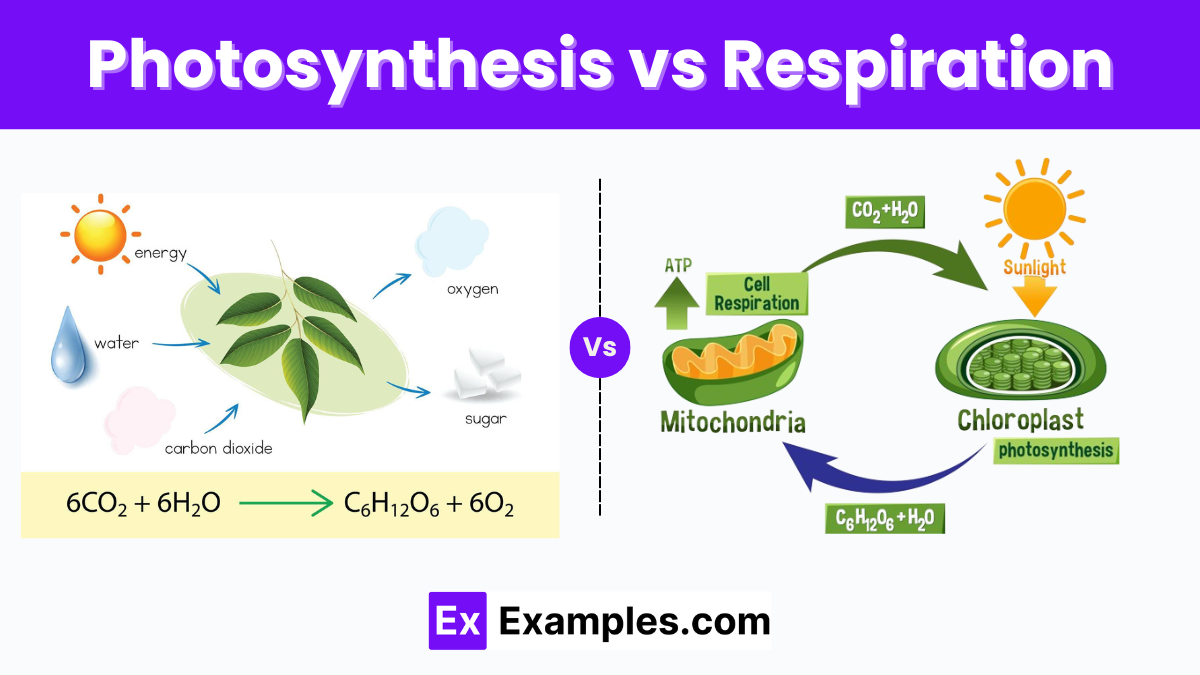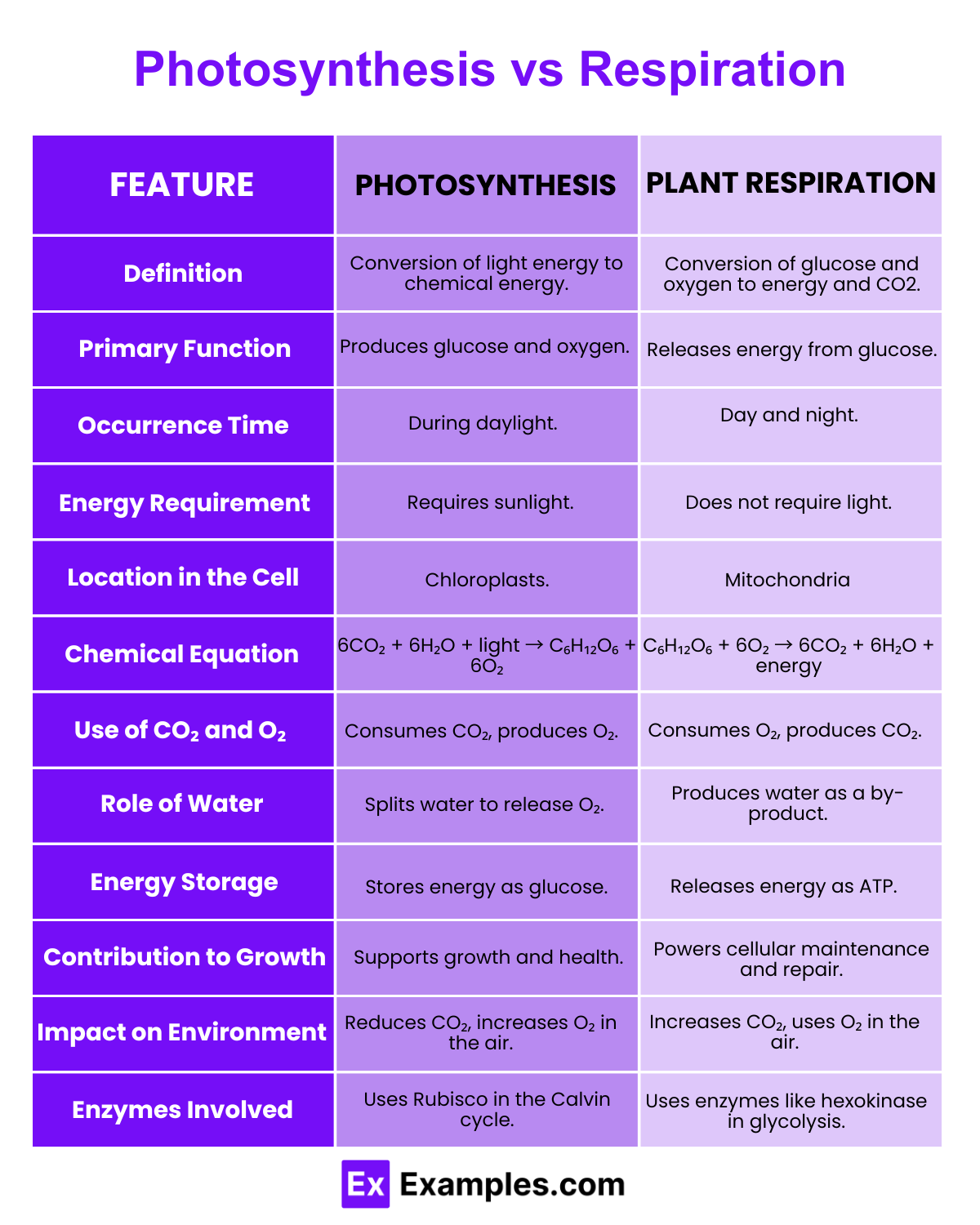What is the primary purpose of photosynthesis in plants?
To produce energy for growth
To release carbon dioxide
To produce glucose and oxygen
To break down glucose


Photosynthesis and plant respiration are two fundamental processes in plant biology, each playing a crucial role in the life cycle of plants. While both are vital for the survival of plants, they serve very different functions. Photosynthesis is the process by which plants, algae, and some bacteria use sunlight, carbon dioxide, and water to produce glucose and oxygen. This process is essential for the production of energy in the form of glucose, which serves as a primary energy source for the plant. On the other hand, plant respiration is the process where plants consume oxygen and use it to turn glucose into ATP, releasing carbon dioxide as a byproduct. This occurs in the mitochondria of the cells and is crucial for energy conversion that fuels all plant activities.
Photosynthesis is the incredible biological process by which plants, algae, and some bacteria convert light energy into chemical energy. This process not only sustains the organism performing it but also supports most life forms on Earth by producing oxygen and organic compounds.
At the heart of photosynthesis lies chlorophyll, the pigment that gives plants their green color. Chlorophyll absorbs sunlight, which serves as the energy source required to drive this process.
Photosynthesis occurs in two main stages: the light-dependent reactions and the Calvin cycle (also known as the light-independent reactions).
1. Light-Dependent Reactions: In this stage, sunlight strikes the chlorophyll in the chloroplasts, exciting electrons to a higher energy state. These high-energy electrons travel through the electron transport chain, a series of reactions that ultimately generates ATP (adenosine triphosphate) and NADPH. These molecules are rich in energy and critical for the next stage of photosynthesis.
2. The Calvin Cycle: The Calvin Cycle does not require light and takes place in the stroma of the chloroplasts. Here, the energy from ATP and NADPH powers the conversion of carbon dioxide from the atmosphere into glucose, a simple sugar. Enzymes catalyze the reactions that convert inorganic carbon into organic compounds, essentially capturing carbon in a usable form.
The primary outputs of photosynthesis are oxygen and glucose. Oxygen is produced as a byproduct of the light-dependent reactions when water molecules are split to release electrons. Plants release this oxygen into the atmosphere, providing the essential element that supports most terrestrial life. Glucose, on the other hand, serves as an energy source for plants and, indirectly, for animals that consume them.
Plant respiration is a crucial biological process where plants convert glucose and oxygen into energy. This process occurs in every living cell of a plant, providing the energy necessary for growth, reproduction, and other vital functions.
Plant respiration takes place in the mitochondria, often referred to as the “powerhouse” of the cell. Here, glucose molecules break down through a series of enzymatic reactions.
Plant respiration can be divided into three main stages: glycolysis, the Krebs cycle, and the electron transport chain.
1. Glycolysis: In glycolysis, glucose molecules split into two three-carbon compounds called pyruvate. This process occurs in the cytoplasm and produces small amounts of ATP and NADH, which are used in further stages of respiration.
2. The Krebs Cycle: The Krebs cycle takes place in the mitochondria. Here, pyruvate undergoes a series of reactions that produce carbon dioxide, ATP, NADH, and FADH2. These products are critical for the final stage of respiration.
3. Electron Transport Chain: In this final stage, NADH and FADH2 generated from the previous stages donate electrons to the electron transport chain in the inner mitochondrial membrane. The flow of electrons through this chain releases energy, which is used to form a large amount of ATP. Oxygen plays a key role here, acting as the final electron acceptor and combining with hydrogen to form water.
The main outputs of plant respiration are carbon dioxide, water, and ATP. Carbon dioxide is released as a waste product during the Krebs cycle and is expelled through the stomata during gas exchange. Water is formed in the electron transport chain, and ATP is produced throughout respiration, providing essential energy for cellular activities.

| Aspect | Photosynthesis | Plant Respiration |
|---|---|---|
| Primary Function | Converts light energy into chemical energy (glucose). | Converts chemical energy (glucose) into usable energy (ATP). |
| Occurs In | Chloroplasts | Mitochondria |
| Input Materials | Carbon dioxide (CO2), water (H2O), and sunlight | Glucose (C6H12O6) and oxygen (O2) |
| Output Products | Oxygen (O2) and glucose (C6H12O6) | Carbon dioxide (CO2), water (H2O), and ATP |
| Energy Requirement | Requires energy (light energy from the sun). | Releases energy (used to power cellular activities). |
| Time of Occurrence | Primarily during daylight when sunlight is available. | Occurs continuously, peaking during night time. |
| Role in Energy Cycle | Energy-storing process. | Energy-releasing process. |
| Impact on Atmosphere | Reduces atmospheric CO2 and increases atmospheric O2. | Increases atmospheric CO2 and consumes atmospheric O2. |
| Dependence on Sunlight | Directly dependent on sunlight. | Not dependent on sunlight. |
| Overall Contribution | Critical for the synthesis of organic compounds; supports biomass accumulation. | Essential for breaking down sugar to provide energy for cellular functions. |
| Thermodynamic Process | Endothermic (absorbs energy). | Exothermic (releases energy). |
| Chemical Process | Reduction (gains electrons). | Oxidation (loses electrons). |
| Efficiency | Less efficient in immediate energy yield; stores energy for later use. | More efficient in immediate energy release for cellular needs. |
| Environmental Influence | Influenced by external factors such as light intensity, CO2 concentration, and temperature. | Less influenced by external light conditions but affected by energy needs and oxygen availability. |
| Global Ecological Role | Drives the carbon cycle, supports oxygenic atmosphere crucial for aerobic life. | Part of the cellular respiration cycle, impacting global carbon and oxygen cycles. |
Despite their distinct roles in plant biology, photosynthesis and plant respiration share several important similarities that underline their interconnectedness within the life processes of plants:
Photosynthesis converts sunlight into glucose and oxygen, while respiration turns glucose into energy (ATP), releasing carbon dioxide.
The Electron Transport Chain (ETC) in photosynthesis generates energy by capturing light, while in respiration, it releases energy by breaking down glucose.
Respiration is generally faster than photosynthesis as it occurs constantly at high rates to meet energy demands.
If respiration exceeds photosynthesis, plants may deplete their glucose reserves, leading to reduced growth and vitality.
Text prompt
Add Tone
10 Examples of Public speaking
20 Examples of Gas lighting
What is the primary purpose of photosynthesis in plants?
To produce energy for growth
To release carbon dioxide
To produce glucose and oxygen
To break down glucose
Where does cellular respiration primarily occur in the cell?
Nucleus
Cytoplasm
Mitochondria
Ribosomes
Which of the following is a common product of cellular respiration?
Glucose
Oxygen
Carbon dioxide
Light energy
What is the main energy carrier molecule produced in cellular respiration?
ATP
ADP
NADPH
FADH2
During which process is glucose synthesized?
Photosynthesis
Cellular respiration
Fermentation
Glycolysis
Which process uses oxygen to release energy from glucose?
Photosynthesis
Cellular respiration
Anaerobic respiration
Fermentation
What are the starting materials for photosynthesis?
Oxygen and glucose
Carbon dioxide and water
Glucose and oxygen
Water and carbon dioxide
Which process is responsible for the production of oxygen?
Cellular respiration
Photosynthesis
Anaerobic respiration
Glycolysis
What happens to the oxygen produced in photosynthesis?
It is used in cellular respiration
It is released into the atmosphere
It is converted into carbon dioxide
It is stored in the mitochondria
Which process does not require oxygen?
Photosynthesis
Aerobic respiration
Anaerobic respiration
Electron transport chain
Before you leave, take our quick quiz to enhance your learning!

